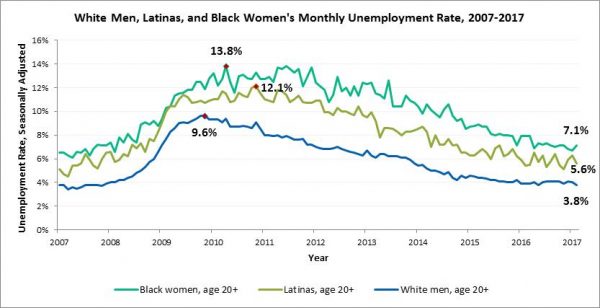Abortion rights, women of color, and LGBTQI+ people are under attack. Pledge to join us in fighting for gender justice.
Despite Job Growth, Black and Latina Women Are Still Being Left Behind

Jobs data were released this morning by the Bureau of Labor Statistics (BLS). The economy added 235,000 jobs in February, and about 6 in 10 of those went to women. The unemployment rate for women ticked down slightly from 4.8 percent in January to 4.7 percent in February. But this overall number masks the broader economic picture for Black and Latina women.

Racial disparities in the unemployment rate still persist, despite a long stint of economic growth after the 2007 recession.
Black and Latina women continue to experience higher unemployment than white men and women. In February, Black women had nearly double (7.1 percent) the unemployment rate of white men (3.8 percent), and while the unemployment rate for Black women increased from January to February by more than a percentage point, the unemployment rate for white men decreased over the same time period. Latinas were also more likely than white men and women to be unemployed.
When we look at data over time, it’s clear that while unemployment rates have gone down, the unemployment rate gap between Black women and white men and between Latinas and white men has shrunk. However, it is still wider than it was before the recession began and despite a record number of months of job growth, Black women and Latinas continue to lag behind white men when it comes to unemployment and the recovery.
Black women’s and Latinas’ economic recovery progressed at a much slower pace than white men’s.
Data over time show very different experiences throughout the recession and subsequent recovery between Black women and Latinas and white men. White men’s unemployment started trending downward in early 2010 while the unemployment rate for Black women did not begin to decline consistently until late 2013—nearly four years after the declared “end” of the recession. Latinas did not see a consistent decline in the unemployment rate until early 2012—nearly two years after the recession was declared over. Even at its peak of 9.6 percent in November 2009, white men’s unemployment remained at least 4.3 percentage points below the peak unemployment rate of Black women, which reached 13.8 percent in April 2010, and 2.5 percentage points below Latinas peak unemployment rate of 12.1 percent in November 2010.
Before, during, and after the recession, white men’s unemployment never went higher than Black women’s or Latina’s.
Through the recession and recovery, white men’s unemployment never climbed into double digits, while Black women’s unemployment remained above 10 percent for 60 consecutive months—five years—from February 2009 until January 2014. People of color, but especially Black men and women, bore the brunt of high unemployment during the recession and their recovery has lagged behind that of white men and women. Let’s hope last months’ movement toward a widening gap in the unemployment rate between women of color and white men doesn’t become a long term trend—these women and their families simply can’t afford it.





